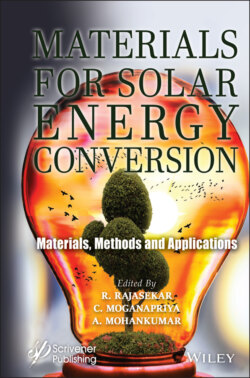Читать книгу Materials for Solar Energy Conversion - Группа авторов - Страница 37
1.10.1 Photovoltaic Effect
ОглавлениеThis is the conversion of light energy into electricity when the solar radiation falls on silicon cells or photovoltaic cells. Two types of p and n semiconductors are used to form p-n junction. When solar energy strikes on the photovoltaic cells, electron hole pairs are created based on internal fields. If the electric field exists over p-n junction which impacts the separation of electron hole pair and free electrons, then flow from n to p type semiconductor to current flow occurs. The working schematic is shown in Figure 1.14.
Absorbing Materials
All the photovoltaic cells need light absorbing materials to capture photons and free electrons, which are placed in a cell structure. Silicon cells play a dominant technology in photovoltaic cells [27]. The most commonly used materials are amorphous silicon, crystalline silicon, cadmium telluride, cadmium sulphide, gallium arsenide, and some other materials.
Silicon
The popularly named material for solar cells is crystalline silicon otherwise called solar grade silicon [28]. Crystalline material gives a maximum efficiency compared to other types of materials. Based on crystal size, the crystalline materials can be classified into single crystal silicon; poly-crystalline silicon has an average efficiency of about 14%–19% [29]. Antireflection coatings help to rise the capturing of light energy into solar silicon cells. Titanium dioxide is chosen as best suited antireflection coating materials due to its good surface quality. Crystalline silicon on glass technique increasing the efficiency rate as 12% to 13% from 8% to 9% of normal solar cells with lesser production price [30].
Figure 1.14 Schematic figure of photovoltaic module.
Amorphous Silicon
One of the most widely spread techniques is amorphous on thin film by plasma-enhanced chemical vapor deposition method, approximately 5% to 7%, and for double, triple junction raised upto 10% [31]. The following materials that are generated from amorphous silicon are amorphous silicon (a-Si), amorphous silicon germanium (a-SiGe), microcrystalline silicon (c-Si), amorphous silicon nitride (a-SiN), and nano-crystalline silicon (nc-Si) [32].
Cadmium Telluride
This material is simple for deposition and best appropriate to large scale industries. It produces high efficiency than other solar cells on thin film technique but its more toxic element [33].
